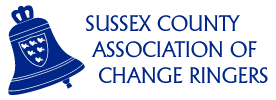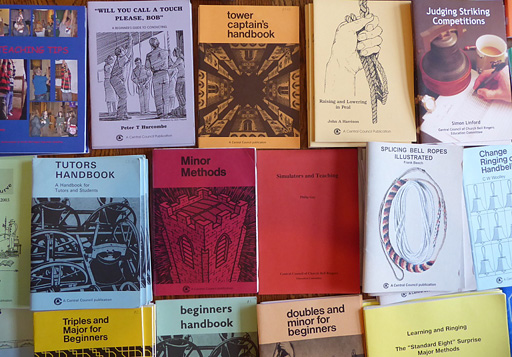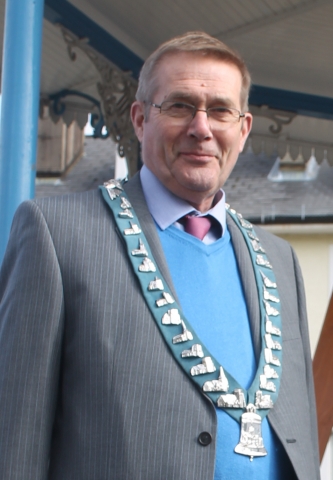The Making of the Master's Chain
It is said that “fools rush in where angels fear to tread”. Many times during the making of the Master’s Chain of Office, I have asked myself: “Why did I take it on?” Yet, I had given a commitment and, as unexpected difficulties arose, I wondered it if would ever be accomplished.
It started easily enough; why should not our Association have a Master’s Chain of Office like all the others. A thought expressed, as an aside, in committee meeting caused a much-respected Vice-President to offer it as a memorial to his forbears – the Wood family, ringers at Billingshurst for many generations. Designs were called for and among them the writer’s was included. This was chosen, and was the beginning of a commitment. The basic design was for each link to represent a Sussex church that had been a foundation member of the Association, and for the whole to be cast in bell-metal. I, therefore, saw no difficulty, for had I not cast in bell-metal some twenty handbells? But (and how dreadful can sometimes be the consequences of that little word) the committee suggested that it be done in silver. Little did I realise that it was stage one of an experience that I shall never forget. The committee went further and wanted instead of metal links between the churches, as is usual in such chains, for the churches to be mounted on blue leather. Blue leather – I had never heard of it – and I was wondering in trepidation where this going to end. Committees designing camels; oh my, I was caught, for I was committed. Well, I had cast a silver ring for my mother, so perhaps it would not be too bad to work in silver.
A mock-up of the proposed chain was made in plumber’s metal (solder). This required producing a finished drawing of the design, modelling each link in plasticine, making a cast in plaster of Paris, extracting the plasticine model and casting the specimen links in the plaster mounds. It looks easy until one finds that undercutting of the plasticine prevents its undamaged removal from the plaster mould, and also stops the metal link from leaving the mould, which therefore has to be broken. Having solved that problem, the mock-up chain was sent to the committee and was approved. There was no backing out. In the weeks that followed, I would clearly have liked to have found a loop-hole, even a tiny one, in order to escape, but it was not to be.
The plasticine models were re-tooled and fresh plaster of Paris moulds were made and painted with shellac to prevent the wax castings from adhering. Each wax model of a church was tooled to the desired finish, and when I was about to prepare the fine loam to form the mould around the waxes, a most fortunate meeting occurred.
We were deep in the planning of Expo ’68 at Ardingly, when Douglas Hughes attended one of our meetings at my home, during which plans were laid for the Expo Belfry. By chance I mentioned that I was working on the chain. It so happened that, at that time, Whitechapel were busy casting 2,400 models of the Liberty Bell using the waste wax process that I was proposing to use for the chain. Now Whitechapel were using ceramic shell moulding, and Douglas Hughes offered to coat the model church waxes for us, and to fire them ready for my casting. I was over the moon, for half of my contemplated troubles had vanished … or I thought they had. One of the problems of waste wax moulding is that this material expands on being melted and can easily crack a mould. The technique used at the foundry rapidly brings the moulds to 1,000º C, vaporising the wax, so preventing cracked moulds. The offer was gratefully accepted, so I proceeded to add a pouring basin with vents and a runner to each wax model and, in due course, the moulds arrived ready for casting.
Now Molly, my wife, has had to put up with me for many years, and with my bell casting experiments in our kitchen fireplace in which I used a specially designed furnace. So, having moved to our present address, I claimed the fireplace in our living room for this next job. Perhaps, with hindsight, she might have said a very firm “No!”, if only she had known what was coming...
The next problem was to clear the position over tax and hallmarking. After a lot of to-ing and fro-ing, the first was resolved and required an undertaking that this was a one-off job, allowing for the fact that I was not in business as a silversmith, neither did I have my own trade mark. The lack of a trade mark caused problems at Goldsmiths Hall, where every silver article is assayed before being hallmarked. If it did not attain the standard purity, it would be destroyed.
Sterling silver was bought from a bullion dealer in London, and brought to Lewes by Roy Towler, a ringer at Ringmer. It was in pieces about one and a half inches square. After obtaining a new crucible, for I dared not use my others for fear of contamination, I was all set to begin.
The furnace was installed in the fireplace with a stock of coke the correct size, and I was away into the unknown. In the try-out, everything was fine. On removing the cover from the crucible, I had one of the most moving experiences of my life. In the melting of all metals there is dross that accumulates as a skin on top of the molten metal; all this has to be scraped away before casting can begin. But not so in this case, for when I removed the crucible cover, there was the molten silver without a trace of dross. It was like a burning white light, as though one was looking through a window into heaven; the light from the furnace being very dim by comparison. The crucible was lifted and two links were successfully cast. At that time, I noticed some discolouration of the surface in the pouring basins and wondered if the metal was hot enough.
The trial run being successful, preparations were made for casting the test of the links the following day. So, full of confidence, I lit the furnace, the metal was put in the crucible and its cover installed. I had decided to keep it in the furnace for a few extra minutes to make sure that the metal was really fluid. Casting time came and pouring began, but what was happening to the metal in the pouring basins? It was developing a balloon-like surface and expanding. By the end of the cast, I was feeling worried, as well I might. Breaking open the moulds revealed that parts of the links were missing. What could be the problem, for I had never seen anything like it before?
I had forgotten a fact, that I had read many years ago – molten silver will absorb oxygen and throw it out on cooling. It was amazing to see the bubbles develop so much that the bulk increased by about one third. How was I to stop oxygen getting into the melt? That was the problem. A hasty phone call was made to Douglas Hughes for advice and help. All he knew was that Gillett & Johnston took on the job of casting a ship’s bell in silver and got into grave difficulties. A meeting was arranged at East Grinstead, halfway between our homes, where we had a conference. We decided to use phosphor bronze as a deoxygent, as it is used in bellfounding. It was to be added to the silver in the proportion of one two-thousandth of an ounce to once ounce of the metal.
Now can you image a carpenter weighing out a two thousandth of an ounce? Well, it had to be done, for I was committed. By dividing an ounce into halves and each half into halves again, I soon reached the limits of my scales. Then I made an even row of the granules of metal and divided the length into half and carried on halving until it was possible to count the granules that went to one two-thousandth of an ounce. This was tried out on the remaining moulds, and it failed! Another conference decided me to use a layer of plumbago over the melt to form a seal from the air. This made a still surface, not easily broken, but, unfortunately, one could not determine when the metal beneath it had melted or was at the right temperature. The result was failure.
By this time, nearly all the moulds required replacing (due to faulty casting) and new wax patterns had to be made. A telephone call from the Whitechapel foundry asked for them to be delivered the following morning (as the foundry was then making more moulds for the Liberty Bells). What could I do? … for I was at work; so Molly came to the rescue, going by train and crossing London to reach the foundry with only two minutes to spare before they started the second part of the process.
This still left me with the problem of getting rid of the oxygen. I then found that silversmiths used centrifugal casting, which causes the semi-plastic metal to fill any gas bubbles. So, centrifugal casting it was to be. An old bicycle wheel was fitted up to the kitchen table with a carrier to hold the crucible, so that a pre-determined amount of metal would pour out of it into the mould, the wheel to be rotated by a cord similar to that used with a ‘Flymo’ grass cutter. Several dry practice runs gave good results, then the molten metal was carried from the front room to the kitchen, the wheel spun and everything seemed fine. It was in the third attempt that the white-hot crucible came adrift, flying through the air and fortunately landing on the tiles surrounding the boiler - and I decided that this method was too dangerous.
About this time, I was wondering if all these troubles had caused contamination of the metal, so I obtained a small amount of pure silver which I added to the stock. Just before assay, a friend did an analysis which confirmed the standard as up to sterling, and interestingly enough, he picked up the fact that one sample was above sterling standard.
After the centrifugal casting experiment, there still were left a number of links to be cast. Then I had a marvellous idea from my boyhood days. In fairgrounds there used to be a tall pole with a bell on the top, and to get a prize one had to hit the end of a pivoted level with a sledge hammer, which sent a weight sliding up the pole until it struck the bell. The force of driving a mould upwards should consolidate the metal during oxygen loss. Why had I not thought of this before? Everything was ready; the metal was poured, the mould went sailing up to the ceiling, and Arundel church was successfully cast.
Most of us at some time in our lives have had a crisis when the brain works at super speed. The mould went up as it should, and then I was aware of a darkened room with globules of light spinning round like planets round the sun. As they fell, they lost their brilliance, and I came to realise that the shock of stopping the mould had spilled the remaining metal in the pouring basin. There was silver everywhere, in my clothes, specks all over the floor in the carpet, a hole burnt in the fabric of the armchair, and the same in Molly’s jumper, which she still has as a memento. What a patient wife I am blessed with!
Another consultation with Douglas and a Mr Hollis, who was helping Whitechapel with the Liberty Bell project, decided I was casting too hot, and between us, the rest of the casting was successfully done, and was I thankful!
The next stage used my experience as a wood carver in working up the links for assay. I took them up to Goldsmiths Hall and waited in trepidation in case I had to do the job all over again. What a relief when they arrived back duly hallmarked. After the final working up and polishing, the blue leather base that had been made by Mrs Read was pierced and the links set in place. Obeying the condition from Goldsmiths Hall that copper wire was not to be used for fastening the silver, I was allowed to use nylon instead.
I have never been so glad to see the end of a job after all the worry and frustration it caused. After that, the making and lining of the “sewing machine” case for it was no problem. Working with wood again was a job!
George P Elphick








